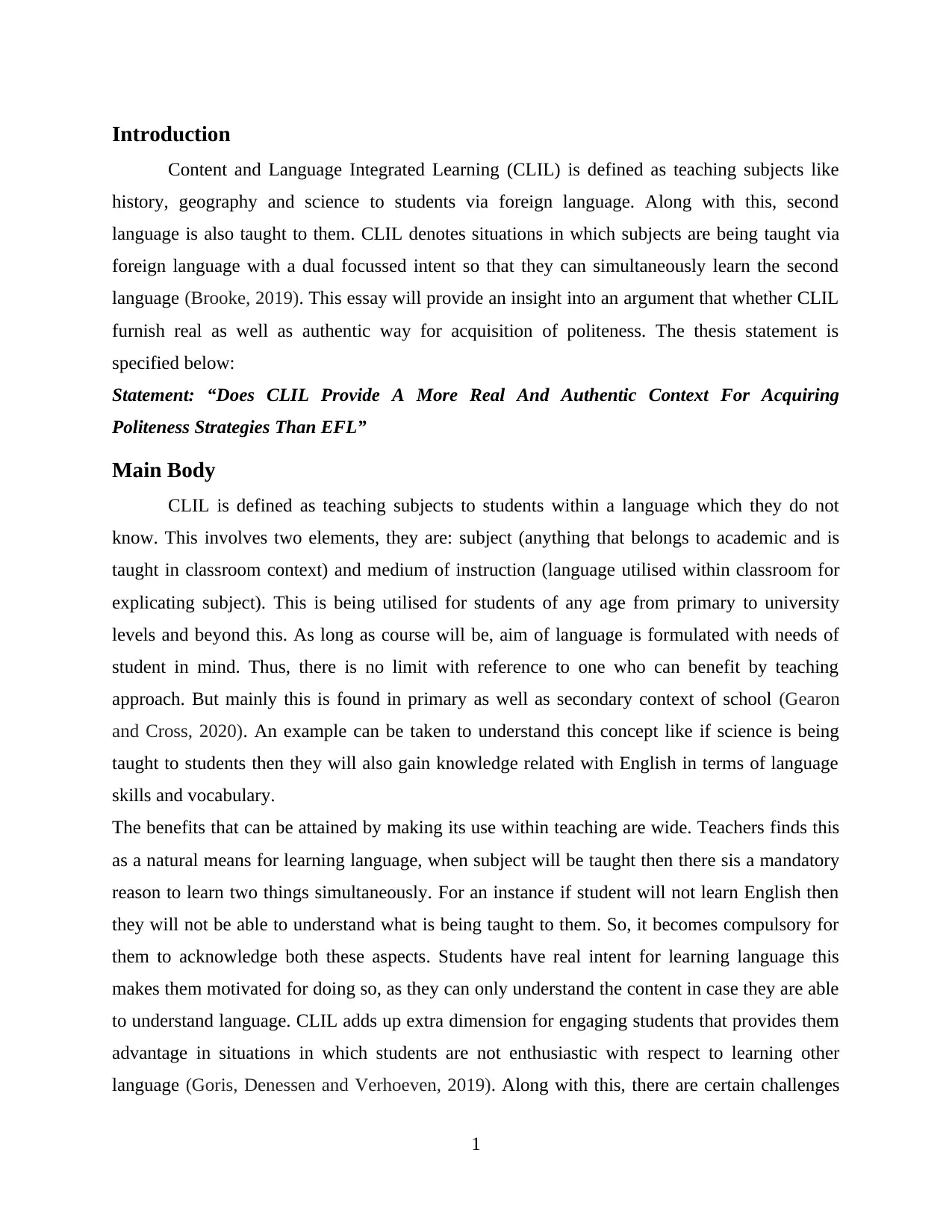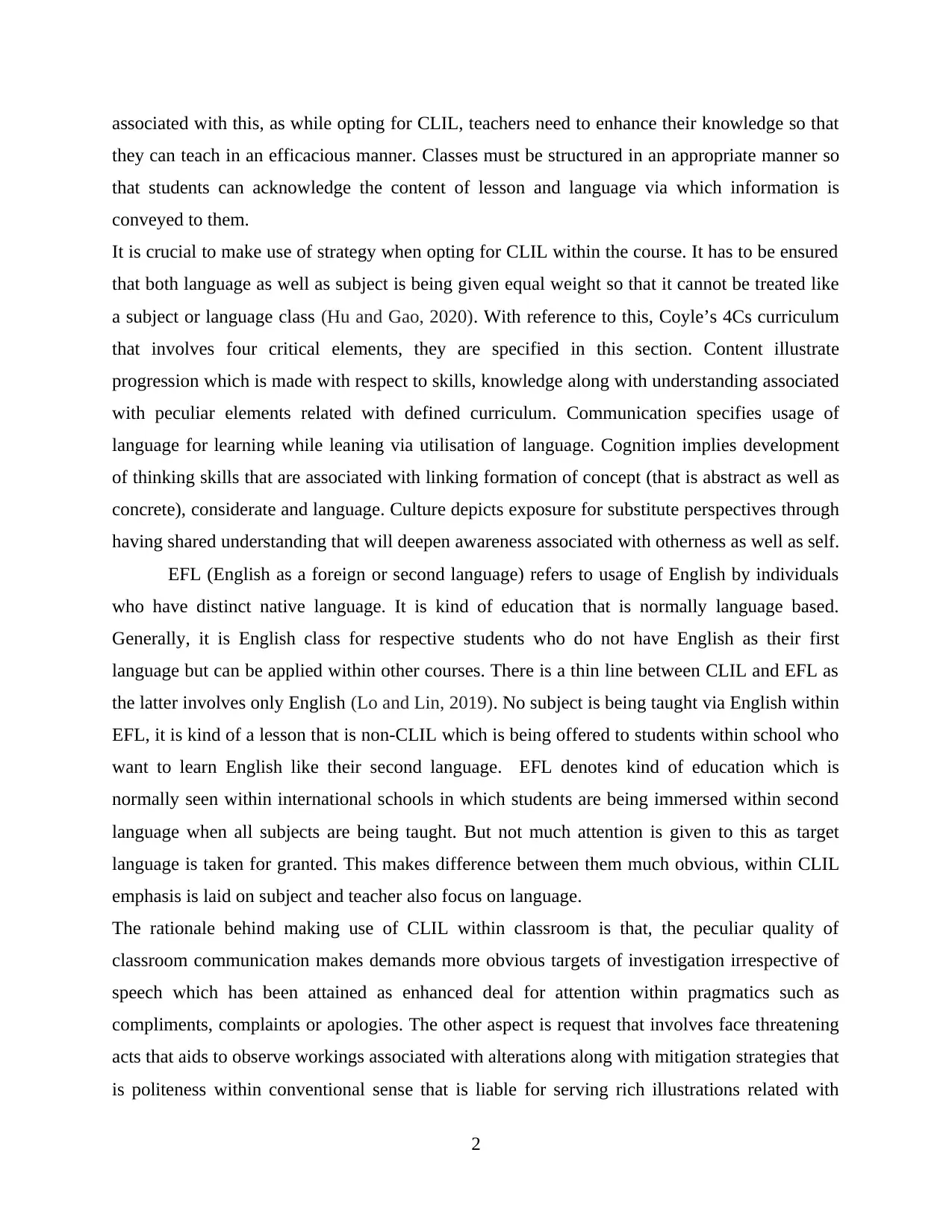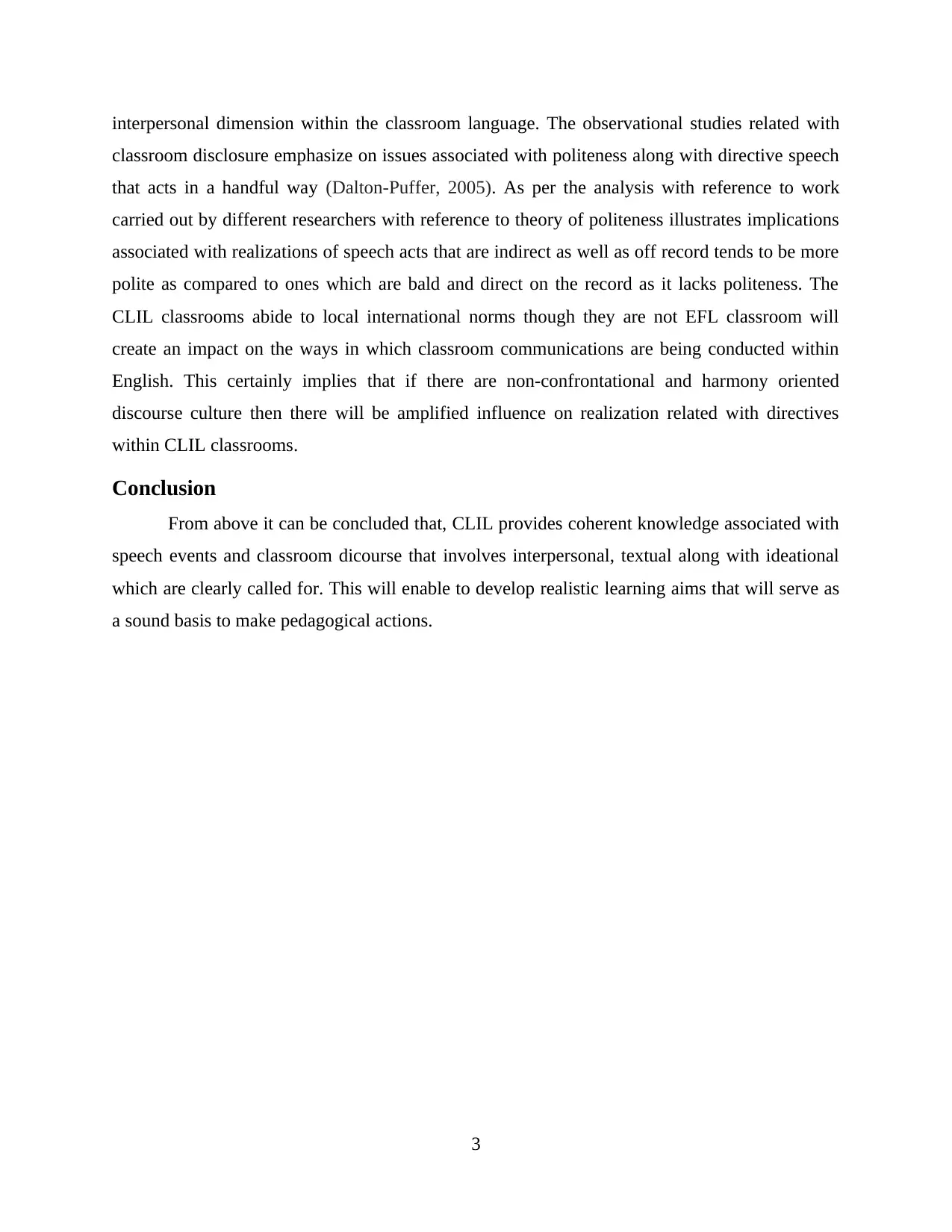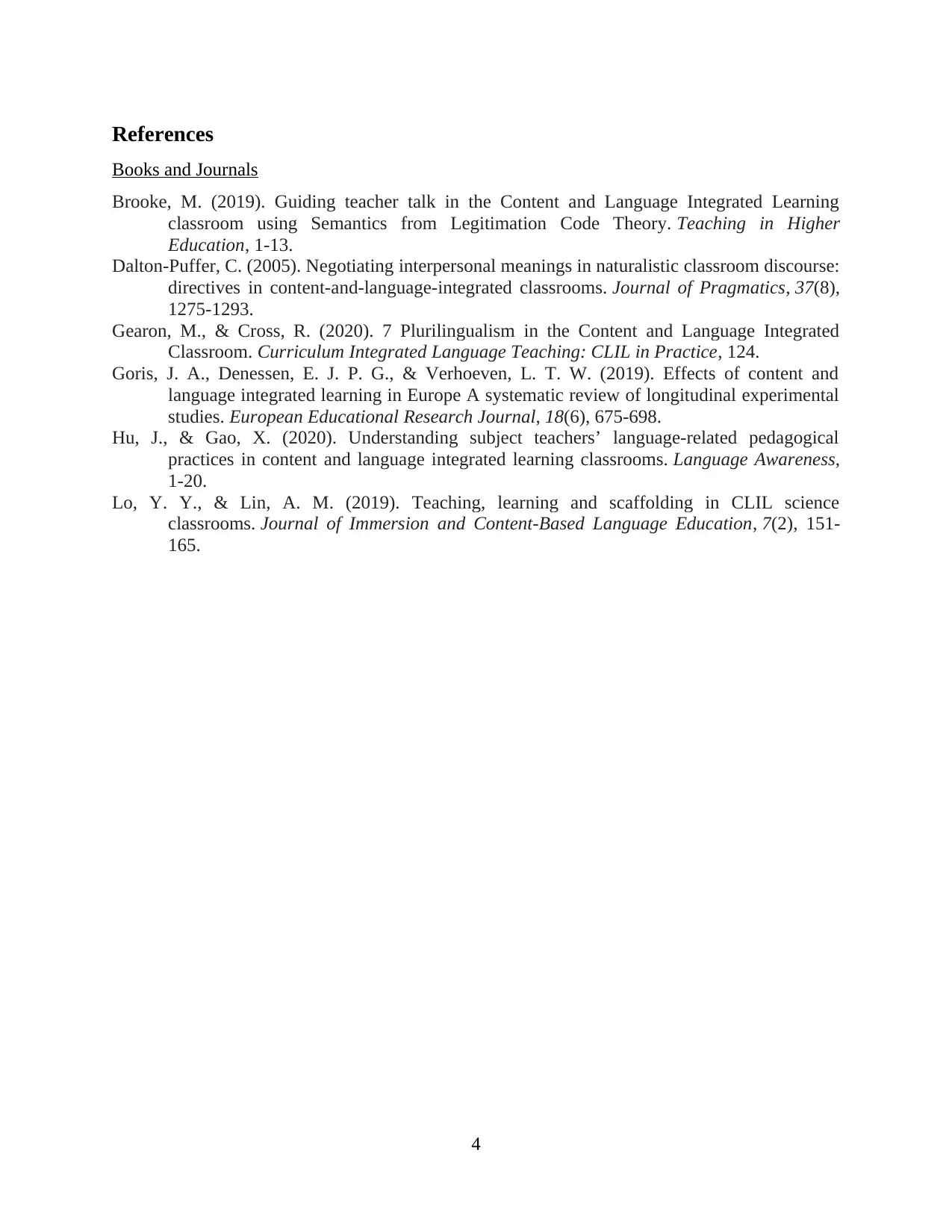Does CLIL Provide A More Real And Authentic Context For Acquiring Politeness Strategies Than EFL
VerifiedAdded on 2023/01/10
|6
|1396
|60
AI Summary
This essay explores the argument of whether CLIL (Content and Language Integrated Learning) provides a more real and authentic context for acquiring politeness strategies compared to EFL (English as a Foreign Language). It discusses the definition and benefits of CLIL, the importance of balancing language and subject, and the differences between CLIL and EFL. The essay concludes that CLIL offers a coherent understanding of speech events and classroom discourse, providing a solid foundation for pedagogical actions.
Contribute Materials
Your contribution can guide someone’s learning journey. Share your
documents today.

Does CLIL Provide A More Real And
Authenticdalton-Puffer 2005 P 1290 Context
For Acquiring Politeness Strategies Than EFL
Authenticdalton-Puffer 2005 P 1290 Context
For Acquiring Politeness Strategies Than EFL
Secure Best Marks with AI Grader
Need help grading? Try our AI Grader for instant feedback on your assignments.

Table of Contents
Introduction......................................................................................................................................1
Main Body.......................................................................................................................................1
Conclusion.......................................................................................................................................3
References........................................................................................................................................4
Introduction......................................................................................................................................1
Main Body.......................................................................................................................................1
Conclusion.......................................................................................................................................3
References........................................................................................................................................4

Introduction
Content and Language Integrated Learning (CLIL) is defined as teaching subjects like
history, geography and science to students via foreign language. Along with this, second
language is also taught to them. CLIL denotes situations in which subjects are being taught via
foreign language with a dual focussed intent so that they can simultaneously learn the second
language (Brooke, 2019). This essay will provide an insight into an argument that whether CLIL
furnish real as well as authentic way for acquisition of politeness. The thesis statement is
specified below:
Statement: “Does CLIL Provide A More Real And Authentic Context For Acquiring
Politeness Strategies Than EFL”
Main Body
CLIL is defined as teaching subjects to students within a language which they do not
know. This involves two elements, they are: subject (anything that belongs to academic and is
taught in classroom context) and medium of instruction (language utilised within classroom for
explicating subject). This is being utilised for students of any age from primary to university
levels and beyond this. As long as course will be, aim of language is formulated with needs of
student in mind. Thus, there is no limit with reference to one who can benefit by teaching
approach. But mainly this is found in primary as well as secondary context of school (Gearon
and Cross, 2020). An example can be taken to understand this concept like if science is being
taught to students then they will also gain knowledge related with English in terms of language
skills and vocabulary.
The benefits that can be attained by making its use within teaching are wide. Teachers finds this
as a natural means for learning language, when subject will be taught then there sis a mandatory
reason to learn two things simultaneously. For an instance if student will not learn English then
they will not be able to understand what is being taught to them. So, it becomes compulsory for
them to acknowledge both these aspects. Students have real intent for learning language this
makes them motivated for doing so, as they can only understand the content in case they are able
to understand language. CLIL adds up extra dimension for engaging students that provides them
advantage in situations in which students are not enthusiastic with respect to learning other
language (Goris, Denessen and Verhoeven, 2019). Along with this, there are certain challenges
1
Content and Language Integrated Learning (CLIL) is defined as teaching subjects like
history, geography and science to students via foreign language. Along with this, second
language is also taught to them. CLIL denotes situations in which subjects are being taught via
foreign language with a dual focussed intent so that they can simultaneously learn the second
language (Brooke, 2019). This essay will provide an insight into an argument that whether CLIL
furnish real as well as authentic way for acquisition of politeness. The thesis statement is
specified below:
Statement: “Does CLIL Provide A More Real And Authentic Context For Acquiring
Politeness Strategies Than EFL”
Main Body
CLIL is defined as teaching subjects to students within a language which they do not
know. This involves two elements, they are: subject (anything that belongs to academic and is
taught in classroom context) and medium of instruction (language utilised within classroom for
explicating subject). This is being utilised for students of any age from primary to university
levels and beyond this. As long as course will be, aim of language is formulated with needs of
student in mind. Thus, there is no limit with reference to one who can benefit by teaching
approach. But mainly this is found in primary as well as secondary context of school (Gearon
and Cross, 2020). An example can be taken to understand this concept like if science is being
taught to students then they will also gain knowledge related with English in terms of language
skills and vocabulary.
The benefits that can be attained by making its use within teaching are wide. Teachers finds this
as a natural means for learning language, when subject will be taught then there sis a mandatory
reason to learn two things simultaneously. For an instance if student will not learn English then
they will not be able to understand what is being taught to them. So, it becomes compulsory for
them to acknowledge both these aspects. Students have real intent for learning language this
makes them motivated for doing so, as they can only understand the content in case they are able
to understand language. CLIL adds up extra dimension for engaging students that provides them
advantage in situations in which students are not enthusiastic with respect to learning other
language (Goris, Denessen and Verhoeven, 2019). Along with this, there are certain challenges
1

associated with this, as while opting for CLIL, teachers need to enhance their knowledge so that
they can teach in an efficacious manner. Classes must be structured in an appropriate manner so
that students can acknowledge the content of lesson and language via which information is
conveyed to them.
It is crucial to make use of strategy when opting for CLIL within the course. It has to be ensured
that both language as well as subject is being given equal weight so that it cannot be treated like
a subject or language class (Hu and Gao, 2020). With reference to this, Coyle’s 4Cs curriculum
that involves four critical elements, they are specified in this section. Content illustrate
progression which is made with respect to skills, knowledge along with understanding associated
with peculiar elements related with defined curriculum. Communication specifies usage of
language for learning while leaning via utilisation of language. Cognition implies development
of thinking skills that are associated with linking formation of concept (that is abstract as well as
concrete), considerate and language. Culture depicts exposure for substitute perspectives through
having shared understanding that will deepen awareness associated with otherness as well as self.
EFL (English as a foreign or second language) refers to usage of English by individuals
who have distinct native language. It is kind of education that is normally language based.
Generally, it is English class for respective students who do not have English as their first
language but can be applied within other courses. There is a thin line between CLIL and EFL as
the latter involves only English (Lo and Lin, 2019). No subject is being taught via English within
EFL, it is kind of a lesson that is non-CLIL which is being offered to students within school who
want to learn English like their second language. EFL denotes kind of education which is
normally seen within international schools in which students are being immersed within second
language when all subjects are being taught. But not much attention is given to this as target
language is taken for granted. This makes difference between them much obvious, within CLIL
emphasis is laid on subject and teacher also focus on language.
The rationale behind making use of CLIL within classroom is that, the peculiar quality of
classroom communication makes demands more obvious targets of investigation irrespective of
speech which has been attained as enhanced deal for attention within pragmatics such as
compliments, complaints or apologies. The other aspect is request that involves face threatening
acts that aids to observe workings associated with alterations along with mitigation strategies that
is politeness within conventional sense that is liable for serving rich illustrations related with
2
they can teach in an efficacious manner. Classes must be structured in an appropriate manner so
that students can acknowledge the content of lesson and language via which information is
conveyed to them.
It is crucial to make use of strategy when opting for CLIL within the course. It has to be ensured
that both language as well as subject is being given equal weight so that it cannot be treated like
a subject or language class (Hu and Gao, 2020). With reference to this, Coyle’s 4Cs curriculum
that involves four critical elements, they are specified in this section. Content illustrate
progression which is made with respect to skills, knowledge along with understanding associated
with peculiar elements related with defined curriculum. Communication specifies usage of
language for learning while leaning via utilisation of language. Cognition implies development
of thinking skills that are associated with linking formation of concept (that is abstract as well as
concrete), considerate and language. Culture depicts exposure for substitute perspectives through
having shared understanding that will deepen awareness associated with otherness as well as self.
EFL (English as a foreign or second language) refers to usage of English by individuals
who have distinct native language. It is kind of education that is normally language based.
Generally, it is English class for respective students who do not have English as their first
language but can be applied within other courses. There is a thin line between CLIL and EFL as
the latter involves only English (Lo and Lin, 2019). No subject is being taught via English within
EFL, it is kind of a lesson that is non-CLIL which is being offered to students within school who
want to learn English like their second language. EFL denotes kind of education which is
normally seen within international schools in which students are being immersed within second
language when all subjects are being taught. But not much attention is given to this as target
language is taken for granted. This makes difference between them much obvious, within CLIL
emphasis is laid on subject and teacher also focus on language.
The rationale behind making use of CLIL within classroom is that, the peculiar quality of
classroom communication makes demands more obvious targets of investigation irrespective of
speech which has been attained as enhanced deal for attention within pragmatics such as
compliments, complaints or apologies. The other aspect is request that involves face threatening
acts that aids to observe workings associated with alterations along with mitigation strategies that
is politeness within conventional sense that is liable for serving rich illustrations related with
2
Secure Best Marks with AI Grader
Need help grading? Try our AI Grader for instant feedback on your assignments.

interpersonal dimension within the classroom language. The observational studies related with
classroom disclosure emphasize on issues associated with politeness along with directive speech
that acts in a handful way (Dalton-Puffer, 2005). As per the analysis with reference to work
carried out by different researchers with reference to theory of politeness illustrates implications
associated with realizations of speech acts that are indirect as well as off record tends to be more
polite as compared to ones which are bald and direct on the record as it lacks politeness. The
CLIL classrooms abide to local international norms though they are not EFL classroom will
create an impact on the ways in which classroom communications are being conducted within
English. This certainly implies that if there are non-confrontational and harmony oriented
discourse culture then there will be amplified influence on realization related with directives
within CLIL classrooms.
Conclusion
From above it can be concluded that, CLIL provides coherent knowledge associated with
speech events and classroom dicourse that involves interpersonal, textual along with ideational
which are clearly called for. This will enable to develop realistic learning aims that will serve as
a sound basis to make pedagogical actions.
3
classroom disclosure emphasize on issues associated with politeness along with directive speech
that acts in a handful way (Dalton-Puffer, 2005). As per the analysis with reference to work
carried out by different researchers with reference to theory of politeness illustrates implications
associated with realizations of speech acts that are indirect as well as off record tends to be more
polite as compared to ones which are bald and direct on the record as it lacks politeness. The
CLIL classrooms abide to local international norms though they are not EFL classroom will
create an impact on the ways in which classroom communications are being conducted within
English. This certainly implies that if there are non-confrontational and harmony oriented
discourse culture then there will be amplified influence on realization related with directives
within CLIL classrooms.
Conclusion
From above it can be concluded that, CLIL provides coherent knowledge associated with
speech events and classroom dicourse that involves interpersonal, textual along with ideational
which are clearly called for. This will enable to develop realistic learning aims that will serve as
a sound basis to make pedagogical actions.
3

References
Books and Journals
Brooke, M. (2019). Guiding teacher talk in the Content and Language Integrated Learning
classroom using Semantics from Legitimation Code Theory. Teaching in Higher
Education, 1-13.
Dalton-Puffer, C. (2005). Negotiating interpersonal meanings in naturalistic classroom discourse:
directives in content-and-language-integrated classrooms. Journal of Pragmatics, 37(8),
1275-1293.
Gearon, M., & Cross, R. (2020). 7 Plurilingualism in the Content and Language Integrated
Classroom. Curriculum Integrated Language Teaching: CLIL in Practice, 124.
Goris, J. A., Denessen, E. J. P. G., & Verhoeven, L. T. W. (2019). Effects of content and
language integrated learning in Europe A systematic review of longitudinal experimental
studies. European Educational Research Journal, 18(6), 675-698.
Hu, J., & Gao, X. (2020). Understanding subject teachers’ language-related pedagogical
practices in content and language integrated learning classrooms. Language Awareness,
1-20.
Lo, Y. Y., & Lin, A. M. (2019). Teaching, learning and scaffolding in CLIL science
classrooms. Journal of Immersion and Content-Based Language Education, 7(2), 151-
165.
4
Books and Journals
Brooke, M. (2019). Guiding teacher talk in the Content and Language Integrated Learning
classroom using Semantics from Legitimation Code Theory. Teaching in Higher
Education, 1-13.
Dalton-Puffer, C. (2005). Negotiating interpersonal meanings in naturalistic classroom discourse:
directives in content-and-language-integrated classrooms. Journal of Pragmatics, 37(8),
1275-1293.
Gearon, M., & Cross, R. (2020). 7 Plurilingualism in the Content and Language Integrated
Classroom. Curriculum Integrated Language Teaching: CLIL in Practice, 124.
Goris, J. A., Denessen, E. J. P. G., & Verhoeven, L. T. W. (2019). Effects of content and
language integrated learning in Europe A systematic review of longitudinal experimental
studies. European Educational Research Journal, 18(6), 675-698.
Hu, J., & Gao, X. (2020). Understanding subject teachers’ language-related pedagogical
practices in content and language integrated learning classrooms. Language Awareness,
1-20.
Lo, Y. Y., & Lin, A. M. (2019). Teaching, learning and scaffolding in CLIL science
classrooms. Journal of Immersion and Content-Based Language Education, 7(2), 151-
165.
4
1 out of 6
Related Documents
Your All-in-One AI-Powered Toolkit for Academic Success.
+13062052269
info@desklib.com
Available 24*7 on WhatsApp / Email
![[object Object]](/_next/static/media/star-bottom.7253800d.svg)
Unlock your academic potential
© 2024 | Zucol Services PVT LTD | All rights reserved.





